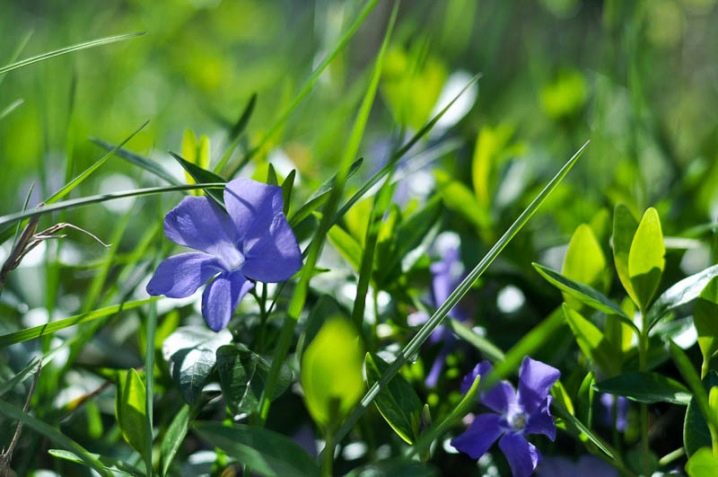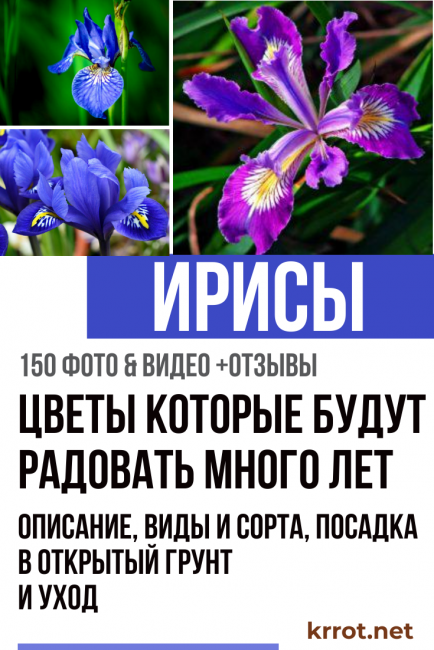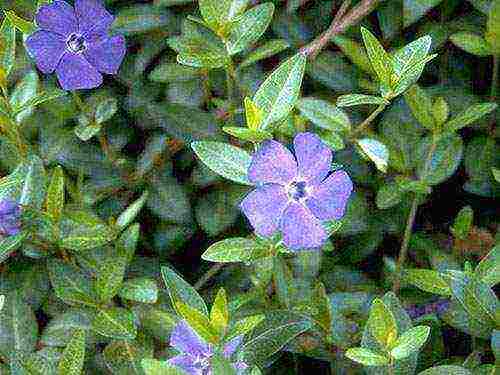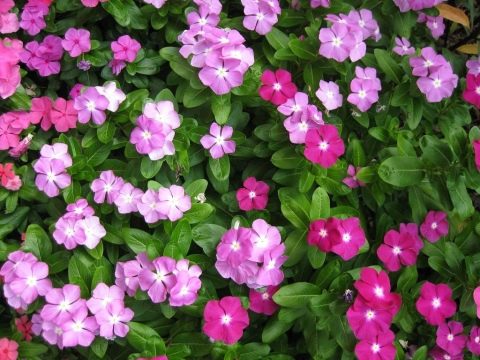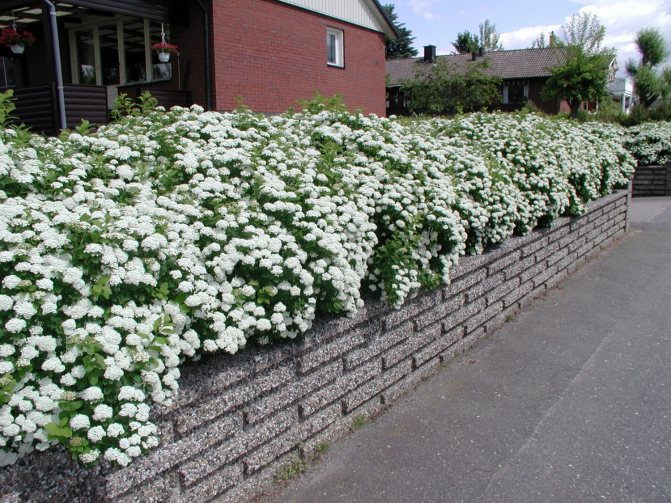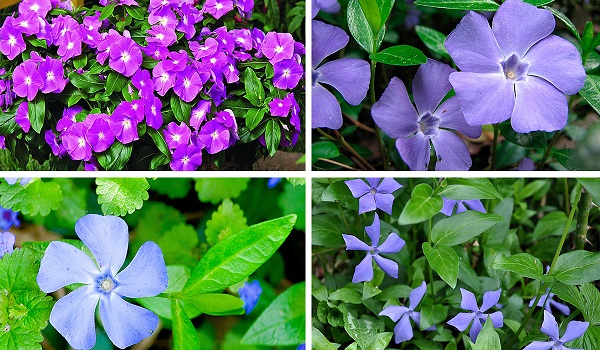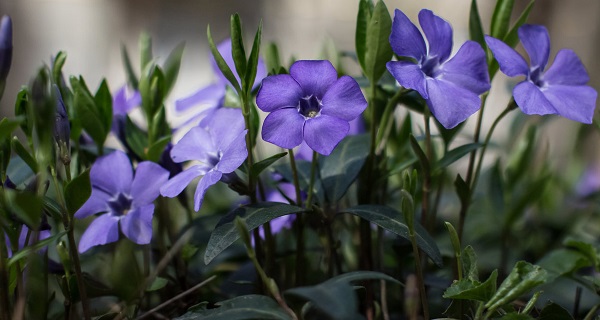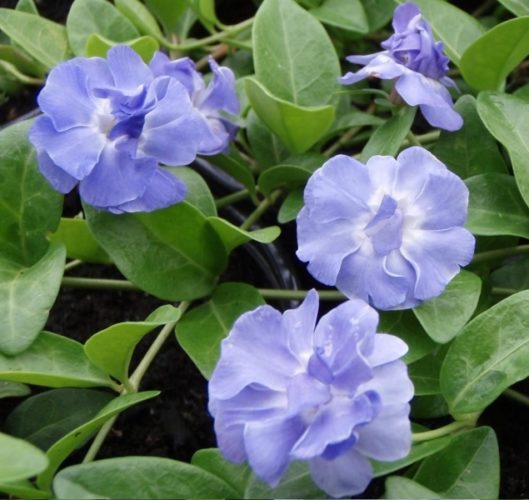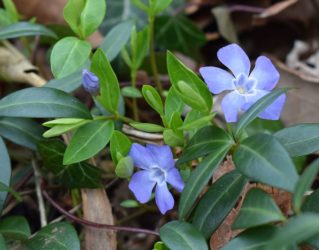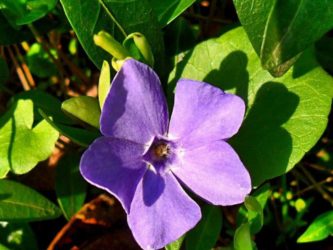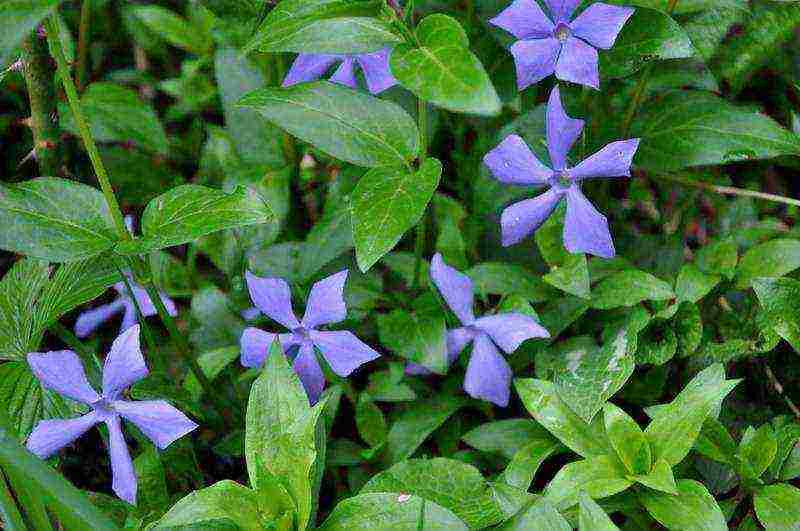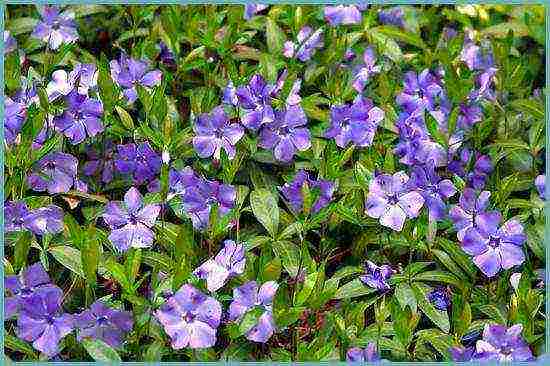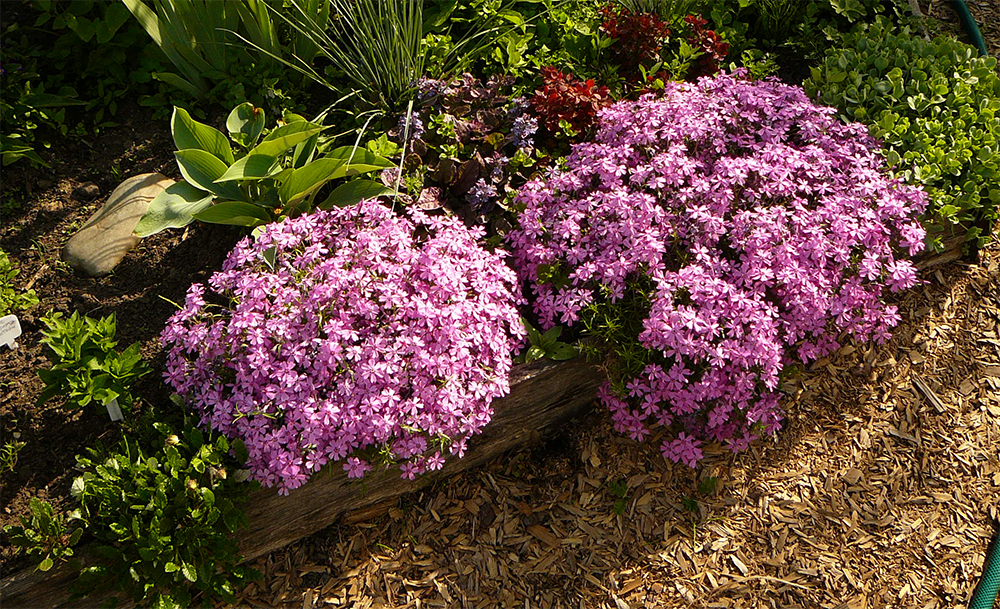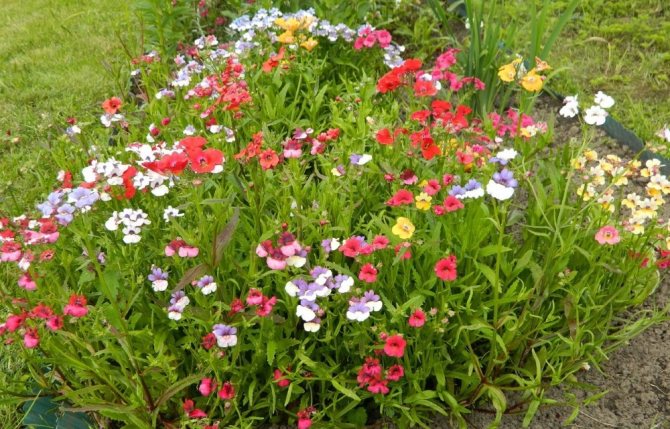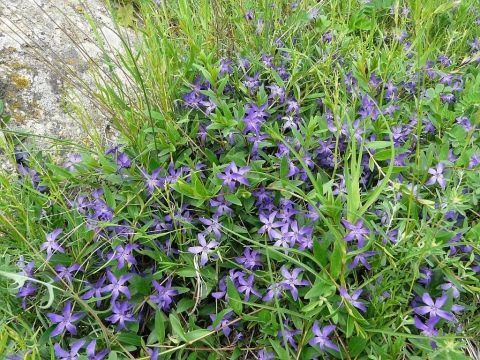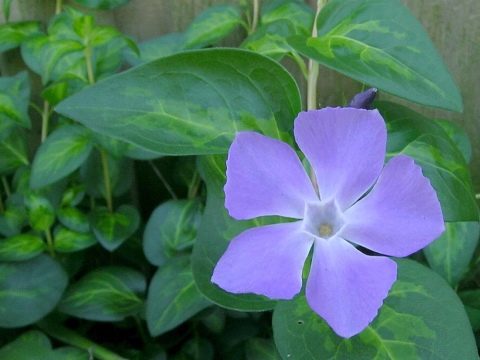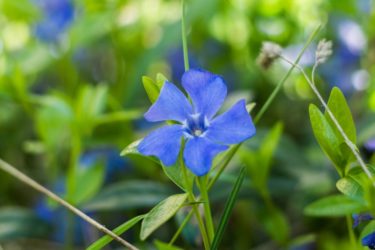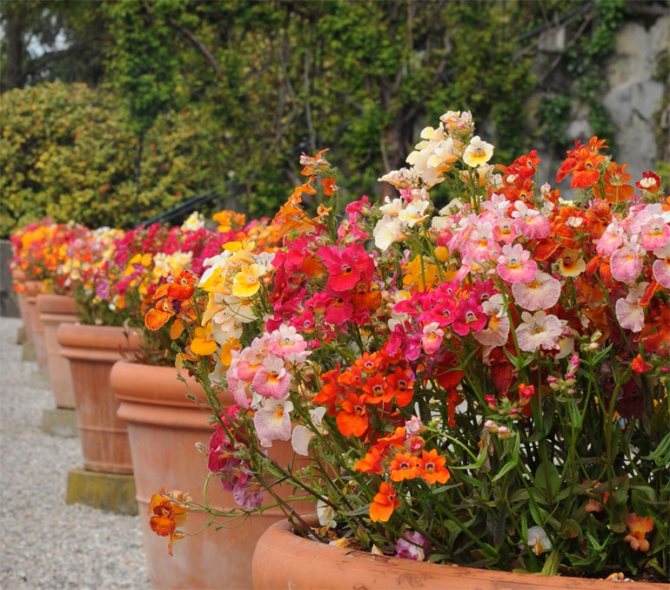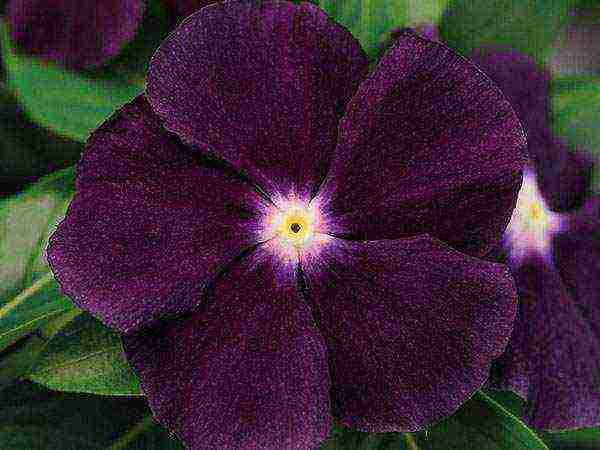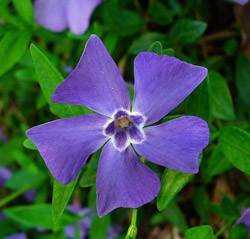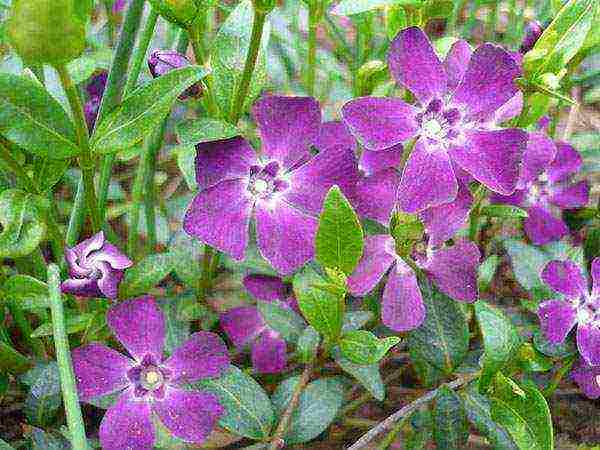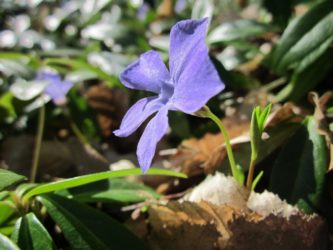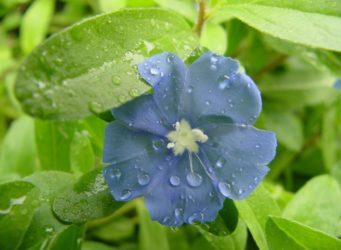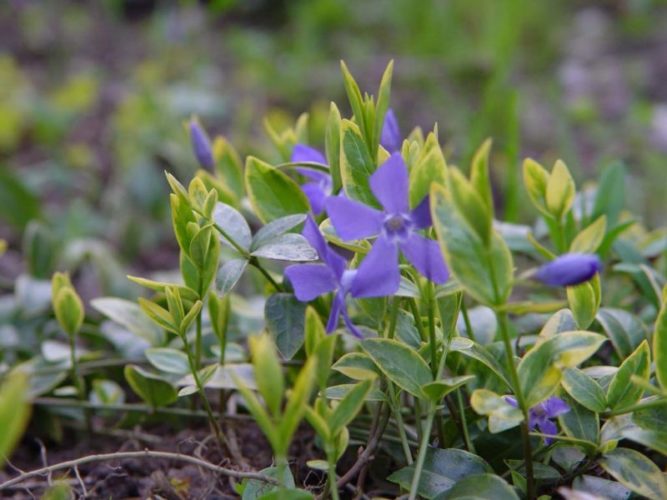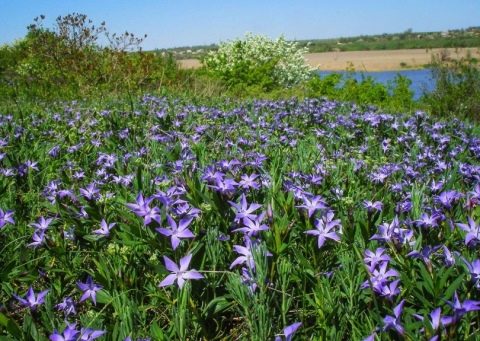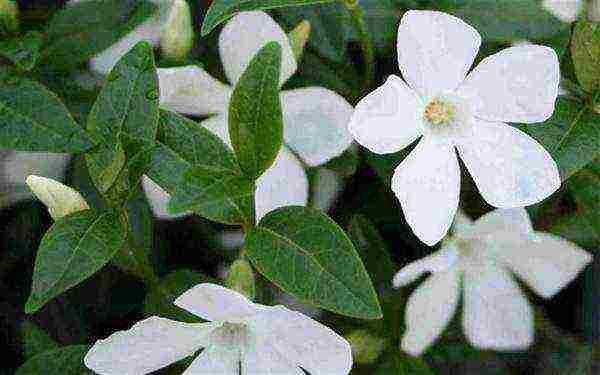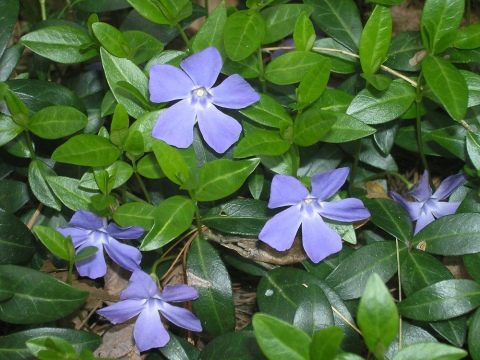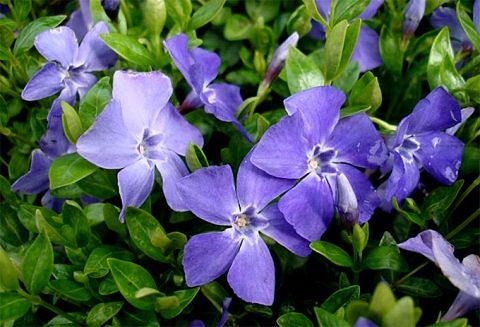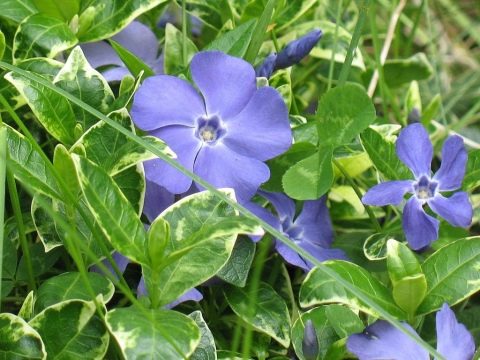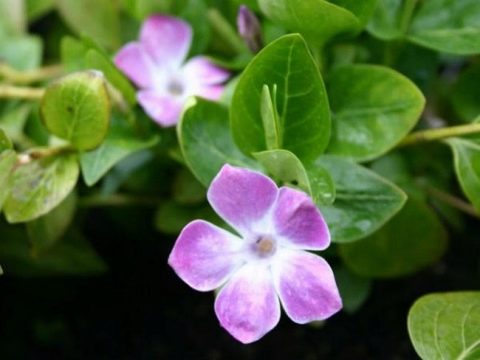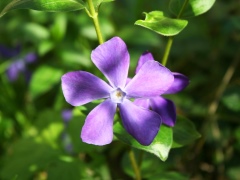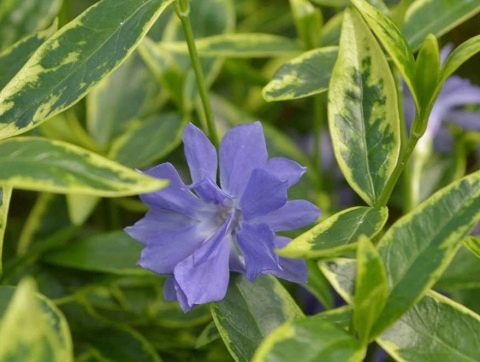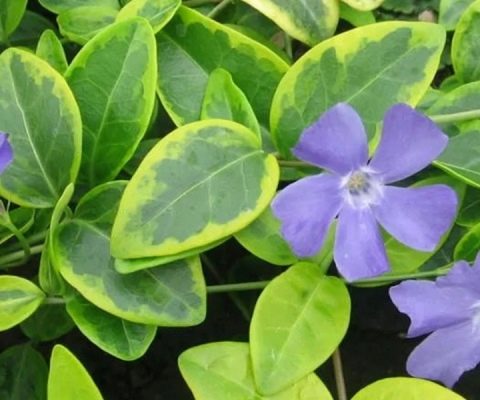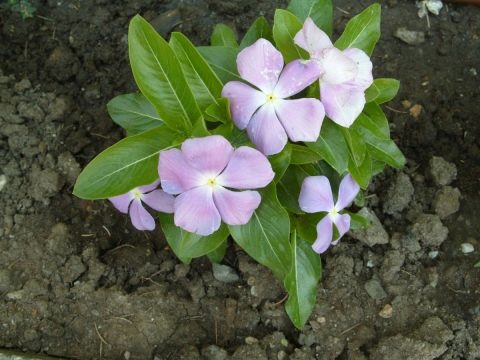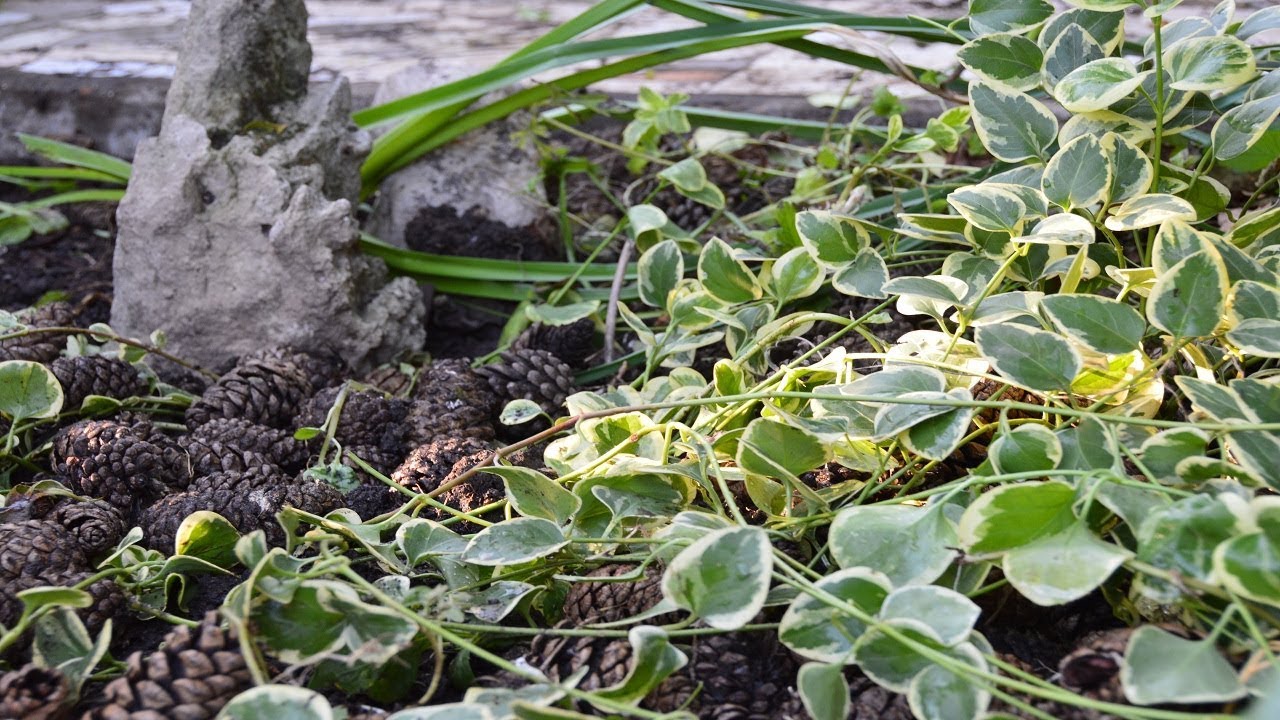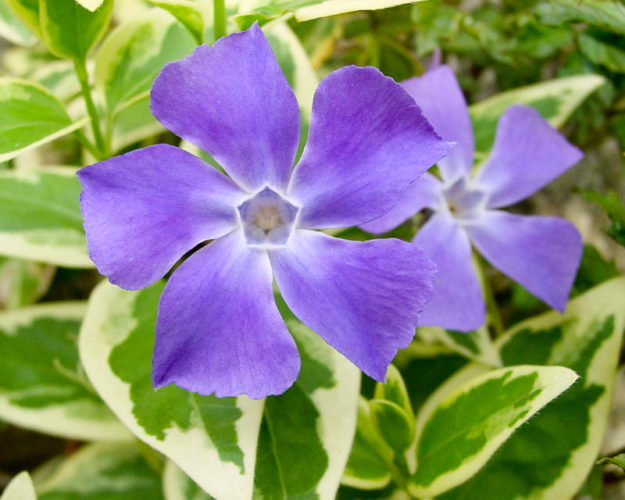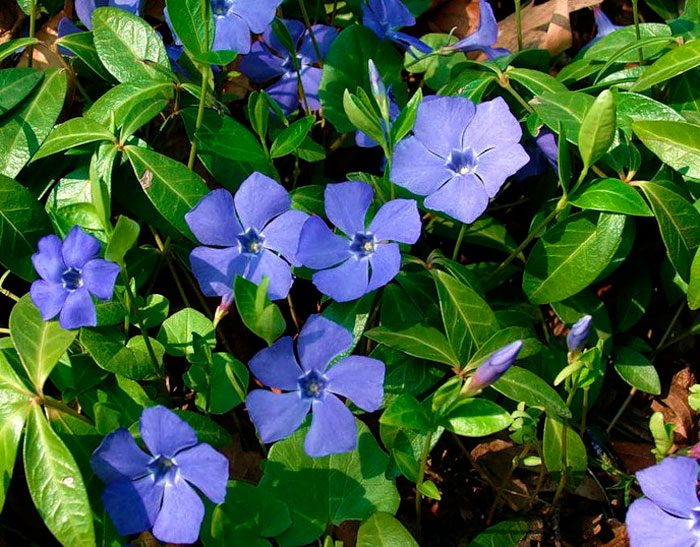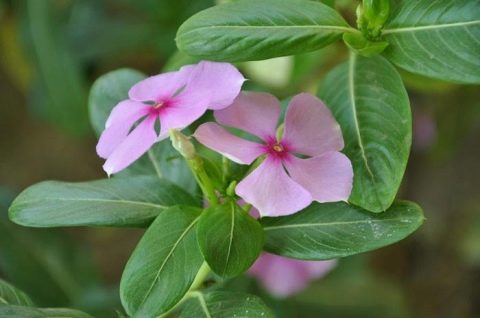The healing properties of the plant
Different types of periwinkles contain a different set of active substances. In medicine, the periwinkle is most often used, it is also medicinal. Its shoots, foliage and flowers contain over 20 alkaloids, bitterness, vitamins, flavonoids, sugars, minerals and tannins. They prevent uncontrolled cell division, therefore they are part of anticancer drugs.
Preparations with periwinkle extract have sedative properties and have a stimulating effect on thought processes. The broth is used to rinse the mouth as an analgesic and anti-inflammatory agent for gum disease or sore throat. It also helps with diarrhea, intestinal or uterine bleeding. Alcohol tincture is taken for fibroids and polyps in the uterus, prostatitis, endometriosis and female infertility.
For all its benefits, periwinkle is a poisonous plant. Even a minor overdose can lead to slow heart rate and heart failure, so it is best to use pharmaceuticals under medical supervision rather than self-medicate.
Breeding
Before planting periwinkle, you need to choose a place for it. It is better if there are garden trees around, they will create the necessary shade. Periwinkle is unpretentious, but it also has its own preferences, it grows well on loose, fertile, not too acidic-alkaline soils. The plant can be propagated by seeds, cuttings or by dividing the bushes.
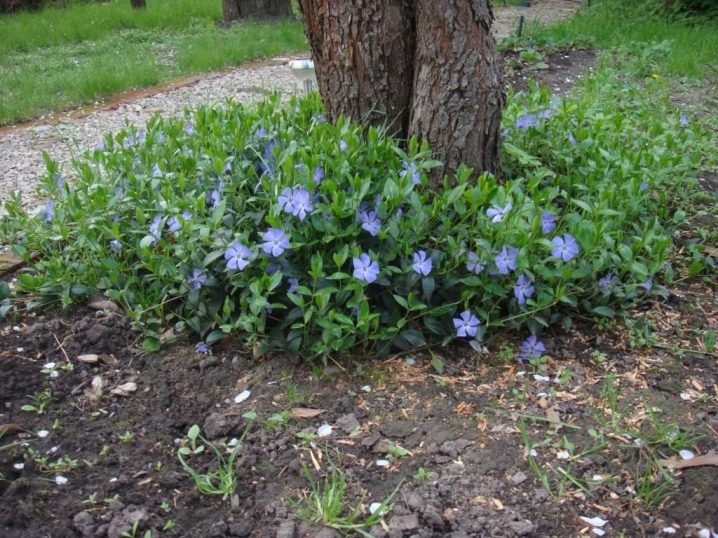
Seeds
Seeds should be planted in early spring or late autumn. Some growers plant in summer, choosing a cloudy, rainy day for this. Before planting, a plot of land is fed with compost, digging it up along with the soil. Grooves are made on the prepared soil, the distance between the rows should be about 10 centimeters. Seeds are sown into the grooves. At the end of the work, the seedlings should be watered.
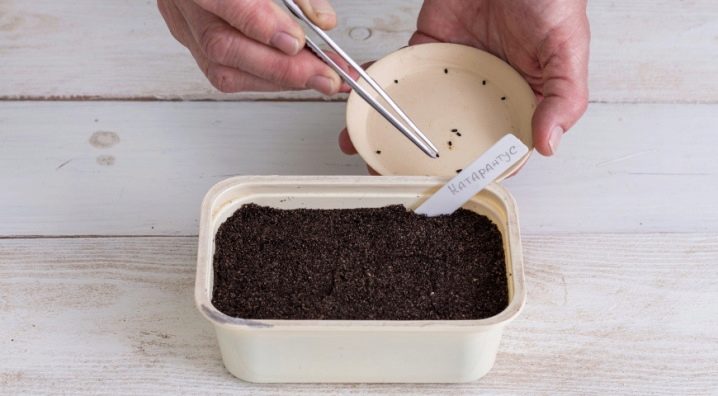
Cuttings
It is safer to land at the end of summer. Then the young plant will have time to get stronger and grow up before the beginning of winter. In such cases, propagation is carried out by cuttings.
In the spring, cuttings are also planted, the distance between them must be observed from 30 to 50 centimeters.
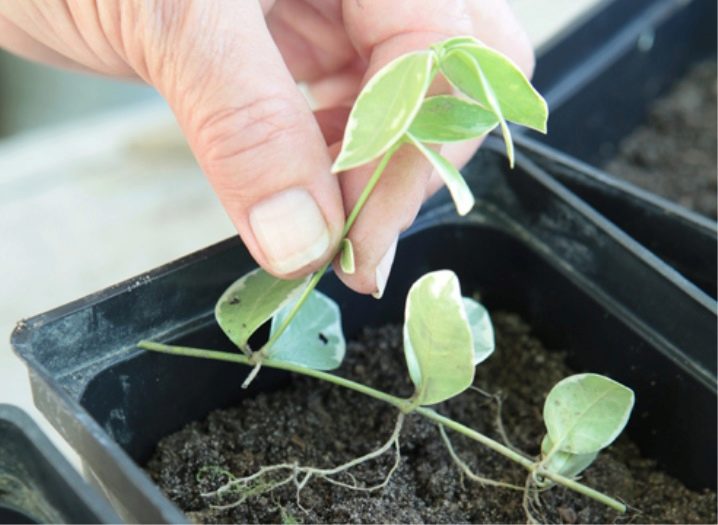
Shoots
For reproduction of periwinkle by shoots, the most developed of them are chosen and sprinkled with a small layer of soil. Layers should be watered periodically until they germinate. Then you can disconnect them, dig up a young shoot with roots and transplant it to another place.

By dividing the bush
This method is used in early spring until the growing season, until young shoots appear. Part of the bush is isolated and transplanted onto a previously prepared soil. For the winter, it is better to cover young plants with spruce branches or straw.
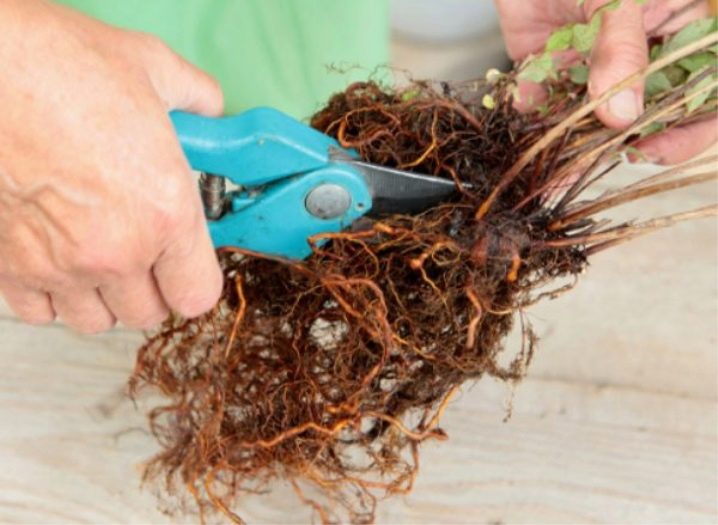
And what is the use?
It is not for nothing that Europeans considered periwinkle a symbol of eternal life (and it doesn't matter that they often planted it in a cemetery). The peculiarity of the flower is that it is almost impossible to destroy it.
He survives in a vase with already dried flowers, as long as there is at least one drop of water. It winters calmly under the snow, preserving the green color of the leaves and is the first to bloom in the spring.
The flower gives the same vitality to people, and its secret is in the composition. In addition to essential oils, organic and tannic acids and minerals, traditional for medicinal herbs, periwinkle contains unique alkaloids. Some of them (the antitumor drugs vinblastine, vinorelbine and vincristine) are included in the List of Essential and Essential Medicines.
Why is periwinkle herb so useful? Its medicinal properties and contraindications are still being studied, but a lot of medicine is official! - has been actively using it for a long time.
- Periwinkle flowers are excellent at lowering blood pressure. Soviet doctors spoke about this feature back in 1956 at the XIV All-Union Congress of Physicians.
- Treats all kinds of bleeding - nose, intestinal, uterine.
- Strengthens and soothes the nerves, it is recommended for neuroses and psychosis, depression and even schizophrenia.
- Helps numb toothache, removes bad breath, stops bleeding from the gums.
- It also lowers intracranial pressure, allows you to relieve headaches and cope with migraines.
- Reduces blood sugar and is used in diabetes mellitus.
- Increases potency in men and is used in the treatment of impotence.
- It cures stomach pains, stops diarrhea, helps with dysentery.
- When applied externally, a decoction of periwinkle heals rashes, sores on the skin, eczema.
- Washing with "violet" tincture makes the skin soft and tender, evens out the complexion.
- Periwinkle is used in the complex therapy of malignant tumors.
Unlike other poisonous medicinal herbs (the same hemlock and bergenia), periwinkle has very few contraindications. But only if you observe the exact dosage! The instruction prohibits drinking weed only with diagnosed heart disease and severe pressure surges. And the doctors add - during pregnancy and lactation, it is also better to remove this herbal medicine out of sight.
Periwinkle: planting and caring for a flower
The soil
Any soil is suitable for the plant, even sandy. However, if the soil is heavy, growth activity will decrease slightly. The development of periwinkle occurs quickly enough, during the season it can capture up to seven square meters with its branches. Do not lose your vigilance - such thickets can harm the "neighbors", or even push them out of the garden altogether.
Pick-up location
Without a doubt, the most favorable will be a sunny area of the garden, but the plant will also feel good in the shade. If you need to disguise unattractive places of your dacha or low buildings - periwinkle will do an excellent job with this task. Surprisingly, even a tree-shaded flower grows beautifully.
Watering
If you want to plant a periwinkle on an area where you will come only for the weekend, then this amount of watering will be enough. Besides, the usual rains are not canceled. Growing a flower in the sultry southern regions, you can water the plant a little more often - the periwinkle will be more beautiful and lush. But there is no need to apply fertilizers so that the periwinkle carpet does not build up greasy greens.
Reproduction
The most optimal way is to dig out some of the plants that have grown over the season and transplant it to another place. Or you can do this: bend the branch to the ground and it will soon take root. They grow a flower and seedlings, and seeds are not a shortage.
Bloom
The plant blooms in mid-May. During this period, the plot with periwinkle simply captivates the eye: blue stars in the emerald sky! After flowering, the stems are trimmed and cut if necessary. Freshly cut twigs can be put in a cool place, and they will delight the hostess with beauty and freshness for about two to three weeks.
Pests
Pests usually bypass the periwinkle, except that aphids can choose young leaves. But you are guaranteed not to find weeds in the green-blue area. The periwinkle tightly covers the soil, and throughout the season the bed looks even and clean, as if it had just been cut.
Application in medicine
Periwinkle is often used in modern medicine and pharmacology. One of the active elements of the flower is an alkaloid that blocks uncontrolled cell division. Means, which include periwinkle, are used in the treatment of oncological processes. In addition, nootropic drugs, as well as immunosuppressants, are made from the plant.
Periwinkle is a wonderful flower, no matter how you look at it.Its beauty, undemandingness, agreement to live on any soil and in different conditions, the ability to look harmoniously in group plantings with annuals and perennials, originality not only in a horizontal arrangement, but also on vertical supports, and in hanging pots - all these qualities make the flower popular and the demand for landscape designers. Periwinkle will be a wonderful garden decoration if you are a busy person. After all, it is a very beautiful plant that does not require special supervision and is completely independent.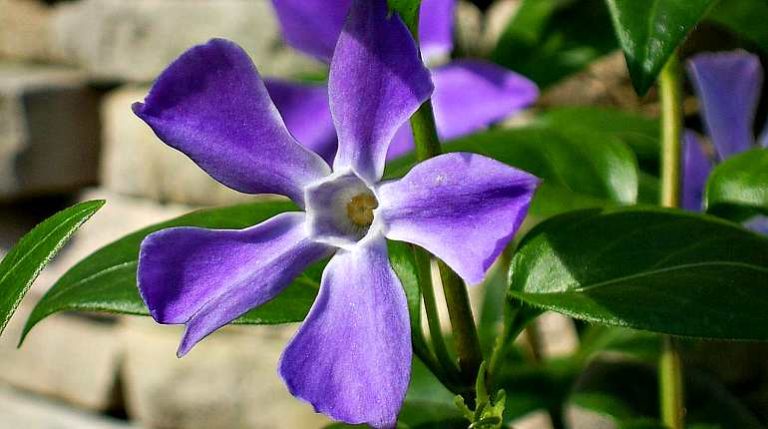
Types and varieties of periwinkle
There are five species belonging to the genus, and three of them are most often grown as an ornamental crop: small, large and variable. A popular indoor flower or an annual in open ground - the catharanthus (pink periwinkle) does not belong to the periwinkle and is singled out as a separate genus catharanthus (lat.Catharanthus). Small periwinkle (Latin Vinca minor). This is a beautifully flowering perennial herb, naturally occurring, as a rule, in deciduous forests, where it settles under the shade of trees or tall shrubs. Natural habitats - Mediterranean, Great Britain, southern Europe, North Africa.
It is a perennial creeping culture with erect or lodging shoots, the average height of which is 20 cm, some specimens can reach 40-50 cm.The leaves are dense, leathery, dark green on top and silvery green on the back of the plate, oval in shape. Single flowers, the shape of which is five petals on a long tube, are colored, depending on the variety, in cold shades, from white to bright purple. Their average size is 2-3 cm in diameter. B. small This is perhaps the most popular garden periwinkle, known in horticulture since the XIV century. A large number of forms of culture have been bred: variegated (f. Variegata), white-flowered (f. Alba), red-flowered (f. Rubra), terry (f. Multiplex). etc. Of the small periwinkle varieties, the following can be noted: "Illumination" - a variegated variety with yellow-golden leaves, decorated with a green border, and bright purple flowers.
"Gertrude Jekyll" (Gertrude Jekyll) - compact (about 10 cm) variety, characterized by dark green glossy leaves and a large number of small snow-white flowers. "Ralph Shugert" (Ralph Shugert) - oval dark green leaves with a narrow silvery-green stripe along the edge and large purple flowers. "Azurea Flore Pleno" (Azurea Flore Pleno) - terry variety, distinguished by delicate light green foliage and lilac-blue flowers. Atropurpurea is a beautiful variety with vibrant mauve flowers. "Burgundy" (Burgundy) - a variety similar to the previous one, with dark burgundy flowers. Blue Drift - Delicate violet-blue flowers and light green leaves. Valley Glow - bright green glossy leaves and snow-white flowers. B. Illumination, B. Gertrude Jekyll, B. Atropurpurea
These are just some of the most famous varieties. In fact, to date, a very large number of periwinkles, varied in color and size, have been bred. Large periwinkle (lat.Vinca major), like the previous species, is often grown in culture. Compared to the small one, it differs in larger sizes: the shoots reach an average of 40 cm, and their maximum length is 90 cm. The dark green leaves are oval-heart-shaped, and the flowers have five petals and a long tubular corolla. The diameter of an individual flower is 3-5 cm, the color of wild-growing specimens is usually soft lavender. Less frost-resistant, in comparison with the small, species found in nature in southern Europe and northern Africa. B. large In culture, the variegated form (f. Variegata) is especially widespread, on the basis of which many varieties have been bred: "Expoflora" (Expoflora) - glossy bright green leaves with a light border. "Maculata" (Maskulata) - the middle of the leaf plate is light, the shade darkens towards the edges."Reticulata" (Reticulata) - the leaves are similar to the previous variety, the flowers are painted in bright lavender, lightening towards the middle. "Wojo's Gem" is a very interesting variety with leaves decorated with contrasting spots. B. "Expoflora", B. "Wojo's Gem" Variable periwinkle (Latin Vinca difformis). This species is rarely found on the territory of our country, because does not differ in frost resistance.
The homeland of the periwinkle changeable is the Mediterranean coast and North Africa, so it is advisable to grow it only in southern regions with mild winters. Under natural conditions, periwinkle is changeable - a rather large (about 50 cm) plant with creeping shoots, oval bright green leaves and lavender flowers reaching 4 cm in diameter. The shape of the petals is asymmetrical, a bit like a spiral. The most famous varieties: "Jenny Pym" (Jenny Pym) - an unusual color of the petals: deep pink at the edges and white in the center. "Ruby Baker" (Ruby Baker) - a variety similar to the previous one, with large dichromatic flowers. "Alba" (Alba) - snow-white flowers against a background of glossy bright green leaves. Snowmound is another white-flowered variety.
General information
Lesser periwinkle is a perennial plant (semi-shrub) of the kutrovy family. It has a long horizontal rhizome, erect stems from 15 to 20 centimeters with blue flowers (2-3 cm). Periwinkle, grown as an ornamental plant, has flowering stems ranging in size from 40 to 60 centimeters. But it "captures" the territory with the help of sterile stems, stretching up to one and a half meters. It is they that allow the plant to vegetatively root.
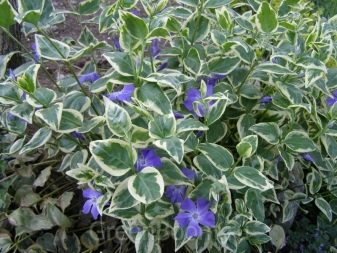

The people call the periwinkle a burial ground. It is often planted on graves, which the plant densely covers with an evergreen carpet. It does not allow weeds to grow, while it itself looks fresh and attractive.
The birthplace of the periwinkle is Europe and Asia Minor, but today it can be found on almost all continents. It grows in steppe ravines and gullies, on forest edges, in bushes and under fences.
